Now
You Can Have Sound and Power
Thunder Monsters By Big City Thunder
By Steve Bohn
Photography: John Gilbert
Probably one of the most modified
systems on any Harley-Davidson these days is the
exhaust system. New V-twins originating from the
Motor Company, or any other major OEMs for that
fact, need to meet stringent requirements set
forth by the EPA.
These requirements deal with issues
such as emissions as well as sound. Anyone that
has a new Harley knows exactly how lethargic they
can sound when fitted with a stock exhaust system.
All too often, riders rush headlong into tearing
the stock pipes off only to replace them with
a set of poorly designed pipes while trying to
achieve a particular exhaust note.
Just pick up any motorcycle magazine
and flip through the pages. Between all the featured
bikes, tech articles, and advertising, the sky's
the limit when it comes to style, shape, size,
and finish of available exhaust pipes. While a
majority of companies producing these systems
spend countless hours on the dyno, computer, and
in the R&D lab to ensure its products squeeze
every last bit of power from the motor, some companies
let performance go by the wayside in the name
of looks or sound.
On the surface exhaust systems
seem like a very simple component attached to
a motorcycle engine, nothing more than a pipeline
to carry away spent gases from the combustion
chamber. Wrong. Exhaust pipes are one of the single
most influential pieces bolted to an engine, which
can increase or decrease its performance. In the
design process, pipe makers need to strike a delicate
balance between a pipe that allows the engine
to perform well, while at the same time creating
an attractive piece that lends itself to the lines
of the bike, along with the ability to create
just that right sound riders are looking for.
Having all of these factors in just the right
combination should provide for a pipe that will
satisfy the majority of riders. The problem is,
while performance can be measured on the dyno
or by seat-of-your-pants testing, other issues
involved in aesthetics or sound are subjective.
A pipe that looks good to one guy doesn't do it
for someone else. A particular sound emanating
from the end of a pipe may be music to one rider's
ear while it's just too loud for the next guy.
A lot of folks go out and pick
up a set of pipes they like the looks of and pull
out the baffles to give them the sound they are
looking for. The problem with doing that is performance
suffers from the lack of backpressure inside the
pipe. This is the same situation seen in many
drag pipes. When you jump on the throttle in the
lower rpm range, the motor falls on it's face
before being able to spin up properly and provide
the power hidden inside. We see this over and
over again on dyno charts where the torque and
horsepower curves drop instead of climb the chart.
So what's the answer? How do you get the look,
sound, and performance you desire? This result
is not as elusive as you might think. To show
how easy it is we contacted Jim Maybeck and Gail
Hamilton, the partners involved at Big City Thunder,
located in Charlotte, North Carolina. Over the
past 3-1/2 years, Jim and Gail have been toiling
to bring a product to riders that allows them
to enjoy the sound of a loud rumbling pipe while
still being able to take advantage of the power
normally lost on straight pipes or ones with modified
baffles.
Big City Thunder's latest incarnation
is known as Thunder Monsters. These parts are
not baffles, but a component designed to give
straight pipes the performance they lack while
at the same time providing a deep, throaty sound
so many riders are after. According to Jim, Thunder
Monsters have just been granted a United States
utility patent based on the performance increase
and sound created by them. While a particular
sound is not patented in itself, the idea that
the product increases performance, at the same
time providing a deep, throaty sound, was pivotal
in the patent process.
With so much emphasis placed on
peak horsepower these days, a step back to look
at reality just might be in order. Large numbers
of riders are far too worried about how much maximum
horsepower their engine is capable of producing
-- both torque and horsepower -- instead of concerning
themselves with midrange power. The folks we ride
with spend the most of their miles riding a bike
spinning the engine in the 2,000- 4,000 rpm range,
not 5,500-6,000 range, where maximum horsepower
is produced. Considering this, it would be fair
to assume most riders, whether they know it or
not, would benefit from more torque and horsepower
in that lower rpm range. That's exactly where
Thunder Monsters were designed to give the maximum
results. To see for ourselves, we ordered a few
different sizes -- they can be ordered in sizes
to fit the following I.D. pipes: 1-5/8, 1-3/4,
1-7/8, 2-, and 2-1/8-inch -- and headed off to
The Cycle Doctor, aka Geoffrey Gaites.
When we arrived at Geoffrey's
Costa Mesa shop he had a couple of bikes lined
up and dyno tested with their existing exhaust
systems. We broke out the Thunder Monsters and
got busy.
SOURCES
Big City Thunder
(704) 366-8672
www.bigcitythunder.com
Cycledoctor
(949) 645-1235
www.cycledoctor.com |
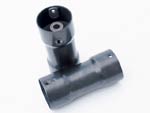
1. What appears at first glance to be a stainless
steel ring terminal is actually a heavy piece
of 304 stainless steel designed specifically to
affect the flow pattern of the exhaust leaving
and entering the pipe. While this sounds like
a simple concept, Big City Thunder invested a
lot of R&D to ensure it would create the desired
effect.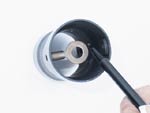
2.
Thunder Monsters are manufactured with a smaller
diameter in the center than on the ends. This
decrease in size aids in speeding up the flow
of gases as they pass through, another design
characteristic.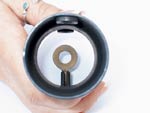
3.
To ensure a long life, Thunder Monsters are made
from carbon steel, then treated to a black anodize
finish.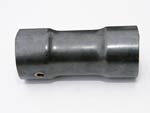
4.
Welded into each end is a 1/4-20 threaded plate,
which allows for insertion in the pipe in either
direction. Flipping the part from end to end will
make minor changes in the performance characteristics
of the pipe.
5.
Thunder Monsters need to be inserted at least
3 inches in from the end of the pipe. In the case
of a slash-cut pipe, measure from the point where
the opening begins (closest to the engine).
6.
Once marked, a 1/4-inch hole was drilled to facilitate
the mounting screw.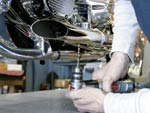
7.
Here Geoffrey inserted the Thunder Monster in
the pipe and secured it with the included screw.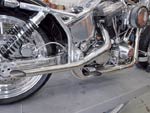
8.
We tried the Thunder Monsters on two separate
bikes: a special construction 80-inch Evo set
up with performance heads, cams, ignition, and
a set of 1-3/4-inch drag pipes, and the bike you
see here, a Twin Cam '02 Fat Boy running a set
of Vance & Hines Long Shots with no baffles.
9.
Special construction: This chart is an extreme
example of how poorly a set of drag pipes can
perform. Look at the starting torque curve (upper
red line) and see how the torque actually decreases
in the 2,600-3,600 rpm range. From there the motor
needs to spin up to 4,100 just to get back where
the power dropped off. The horsepower, while not
as dramatic, is very flat from 2,500-3,650, before
finally taking off. The increase in the torque
curve after installation shows a huge increase
over stock all the way to 4,600. Once again horsepower
shows a dramatic gain in this area as well. Although
maximum horsepower and torque are slightly less
with the Thunder Monsters, the chart shows gains
in the 10-20-plus range for torque and 5-15 hp.
When you consider a pair of Thunder Monsters will
set you back about 80 bucks, this is a phenomenal
return on you investment.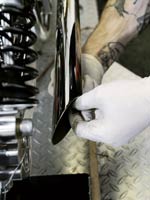
10.
Twin Cam: While not as dramatic as the gains on
the Evo, the Thunder Monsters picked up pretty
close to 10 lb-ft of torque between 2,500-3,500
rpm and a good 5 hp across that same range. Without
a doubt, the rideability of both of these bikes
will be greatly increased while keeping the sound
of the bike deep and throaty.
|